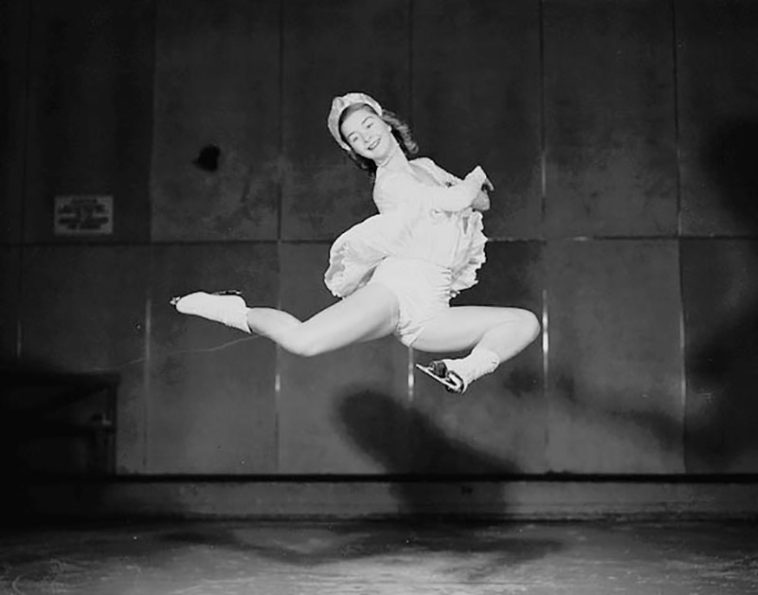The Apostrophe Blog
Photo: Barbara Ann Scott, 1947. Frank Royal / National Film Board of Canada / Library and Archives Canada
I recently returned to writing poetry after years in the prose wilderness, writing short stories and the inevitable attempt-at-novel. While I’d never abandoned the reading poems—a love from way back when—in graduate school, my workshops and classes were focused around the craft of fiction. Oh, I waded into the deep waters topics like the Erotic, the Body, and the Other in Shakespeare, of course. And took the very unfashionable “Epic Poetry” seminar when everyone else was talking Barthes and Foucault and Derrida. Homer, Virgil and Ariosto’s Orlando Furioso, yes!
Still, my serious and focused “book-learning” when it comes to poetry—the mechanics, the critical essays, the theory, even the names of schools and historical periods—remained just about nil until, five years ago, when I unexpectedly found myself wanting and needing to write poems again. That’s when I found myself to be way “behind” on reading widely and deeply in contemporary poetry, a rich, eclectic, and thriving scene for certain these days. All this means is that I’ve had lots of catching up to do—on terms of art, tricks of the trade, finding the proper tools in my personal poetic toolbox and keeping them sharp and clean.
So now, as part of my attempt to “catch up,” I’m most delighted when I stumble upon an essay, an idea, a book of poetry, or a recommendation of a particular poet whose work speaks to what it is I find myself attempting to do here and now. There is, as we all know, nothing new under this sun.
That’s what happened this week when I pulled Robert Bly’s slim 1972 volume, Leaping Poetry: An Idea with Poems and Translations from my shelf. (Another book I’d been reading, The Poetry Home Repair Manual by Ted Kooser had made a reference to it.)
Part critical essay, part anthology, I was surprised to find that, apparently, I’d read it once before. Faint pencil checkmarks in the margins where I’d experienced my aha! moments were still visible, testimonial to that fact. But truth to tell, I have no memory of that. Maybe it was one of those books that I read too soon, before I had any frame of reference to really get, to really understand the fuss of what Bly was really talking about.
Here is one of the first bits of text I’d pencil-checked:
“In many ancient works of art we notice a long floating leap at the center of the work.”
Leaping is the ability to associate fast, and, in Bly’s view, associative freedom is desired and desirable in both the form and content of a poem. By the end of the nineteenth century, poetry had already began to come more from the unconscious; the world of dreams—the only remnant of associative freedom from ancient times according to Freud—had begun to be set free.
Deepen the range of association in a poem. Increase its speed. Fly.
William Blake—another icon I need to further study—was an early practitioner of such flights. Rainer Maria Rilke as well. In Leaping Poetry, Bly also celebrates the Spanish poets, García Lorca and Vallejo, two exuberant exemplars of this bounding wildly on the page. Contemplation of the powers of wild association also returns us to García Lorca and his idea of duende, imagine that. Bly also suggests that the French and Spanish surrealist poets would be worth of study as well.
When this book was written in the early 1970s, Robert Bly was convinced that only a handful of poets in our more hidebound, black-or-white-with-no-shades-of-gray western tradition had already made this leaping and associative seismic, psychic shift. See John Ashbery, Hart Crane, Gary Snyder, even some Wallace Stevens for starters.
“When the poet brings to the poem emotions from his thought-life and his flight-life, emotions that would be intense whether the poem were written or not, and when he succeeds in uniting them with the associative powers of the unconscious, we have something different from Homer…which we could call the poem of ‘passionate association,’ or ‘poetry of flying.’”
What was I looking for when I opened Bly’s little book? A reminder of just what this crazy notion of leaping really was? Yes. Guidance as to how to recognize and cultivate such leaping in my own work? Yes, again. How to make those leaps, maintain faith in them, willingly follow them as they reconnoiter in and around and out? Most definitely. Reassurance that I wasn’t touched or crazy or suffering from an acid flashback whenever I noticed my own words heading fast and furious for such improbable loop-de-looping and occasionally unintelligible leaps and associations all on their own? Of course.
I suppose it ought to bother me that something I instinctively migrated toward in my own work was actually given a name—Leaping Poetry—so long ago that fashions have moved on once, twice, dozens of time since in pursuit of the Next Big Thing. But you know what a real benefit of coming to an engagement with poetry late? I don’t really care.
It’s all new, all news to me. And if the shoe fits…why not take it off and leap?
So, which is it—leap before you look? leap after you look? Hell, what about simply leap and don’t look and see where you end up?
Leap because you must.
Leap because you write. Only leap.
- Published but Uncollected: “My Bikini Goes to Goodwill” - June 17, 2025
- So Much Beauty… - May 27, 2025
- Blank Verse: Old-Fashioned Yet Modern - May 25, 2025

